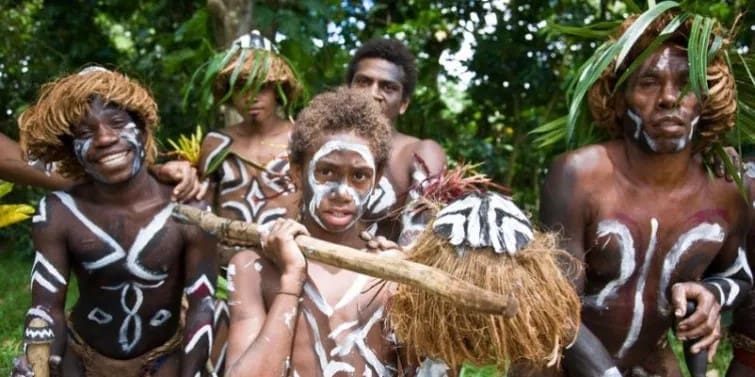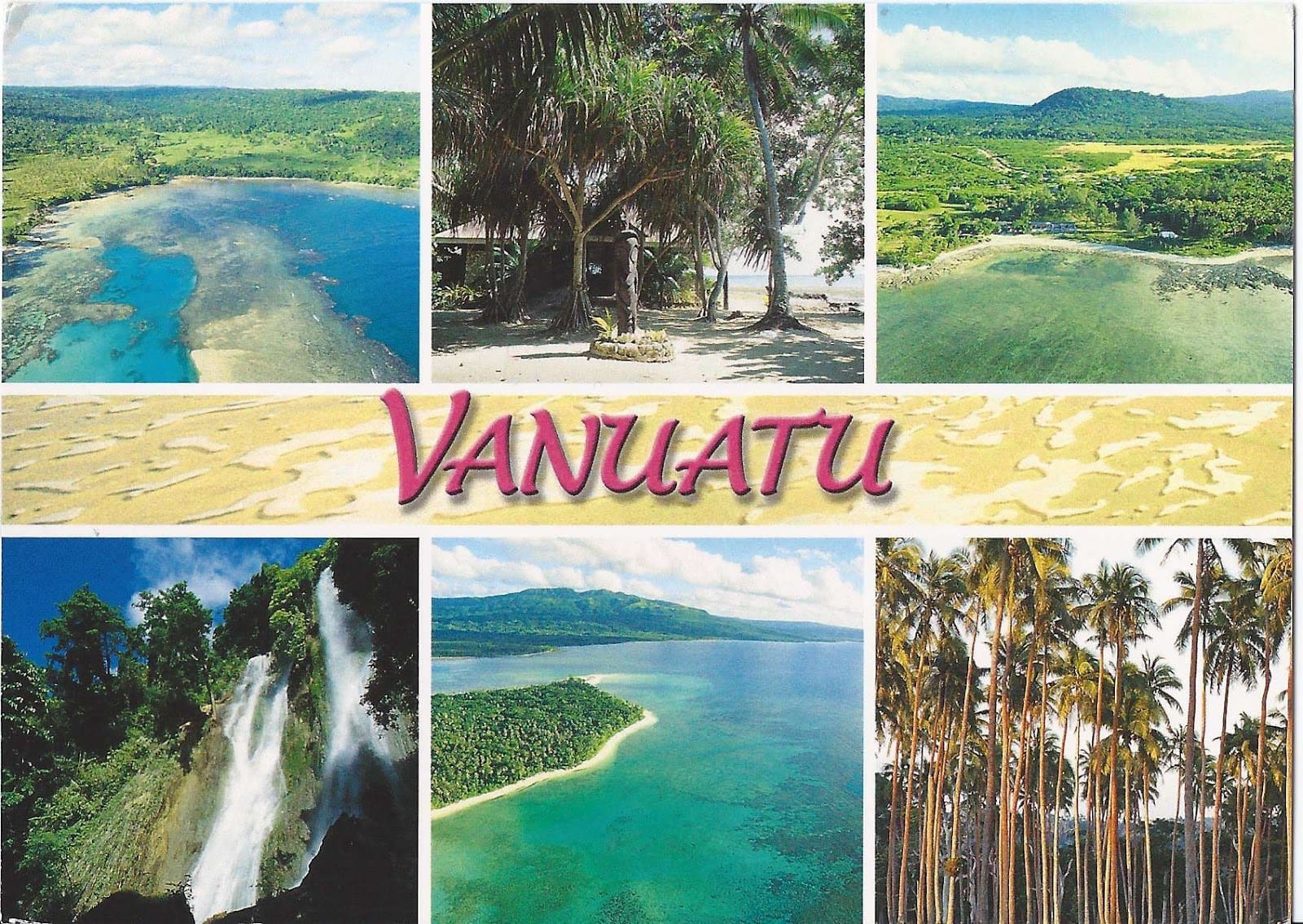Vanuatu, Bislama and French pronunciation [vanuatu], officially the Republic of Vanuatu (French: République de Vanuatu; Bislama: Ripablik blong Vanuatu), is an island country located in the South Pacific Ocean. The archipelago, which is of volcanic origin, is 1,750 kilometres (1,090 mi) east of northern Australia, 540 kilometres (340 mi) northeast of New Caledonia, east of New Guinea, southeast of the Solomon Islands, and west of Fiji.
Vanuatu was first inhabited by Melanesian people. The first Europeans to visit the islands were a Spanish expedition led by Portuguese navigator Fernandes de Queirós, who arrived on the largest island, Espíritu Santo, in 1606. Queirós claimed the archipelago for Spain, as part of the colonial Spanish East Indies, and named it La Austrialia del Espíritu Santo.
In the 1880s, France and the United Kingdom claimed parts of the archipelago, and in 1906, they agreed on a framework for jointly managing the archipelago as the New Hebrides through an Anglo–French condominium.
An independence movement arose in the 1970s, and the Republic of Vanuatu was founded in 1980. Since independence, the country has become a member of the United Nations, Commonwealth of Nations, Organisation internationale de la Francophonie and the Pacific Islands Forum.
| Republic of Vanuatu | |
|
|
|
 |
|
| Capital
and largest city |
Port Vila Coordinates: 17°S 168°E |
| Official languages |
|
| Ethnic groups
(1999) |
|
| Religion
(2010) |
|
|
Demonym(s) |
Ni-Vanuatu and Vanuatuan |
|
Independence |
|
| • from France and the United Kingdom | 30 July 1980 |
| • Admitted to the United Nations | 15 September 1981 |
|
Area |
|
| • Total | 12,189 km2 (4,706 sq mi) (157th) |
|
Population |
|
| • 2020 estimate | 307,815(181st) |
| • 2016 census | 272,459 |
| • Density | 19.7/km2 (51.0/sq mi) (188th) |
| Currency | Vanuatu vatu (VUV) |
| Time zone | UTC+11 (VUT (Vanuatu Time) |
CULTURE
Vanuatu culture retains a strong diversity through local regional variations and through foreign influence. Vanuatu may be divided into three major cultural regions. In the north, wealth is established by how much one can give away, through a grade-taking system. Pigs, particularly those with rounded tusks, are considered a symbol of wealth throughout Vanuatu. In the centre, more traditional Melanesian cultural systems dominate. In the south, a system involving grants of title with associated privileges has developed. Young men undergo various coming-of-age ceremonies and rituals to initiate them into manhood, usually including circumcision.
Most villages have a nakamal or village clubhouse, which serves as a meeting point for men and a place to drink kava. Villages also have male- and female-only sections. These sections are situated all over the villages; in nakamals, special spaces are provided for females when they are in their menstruation period.
TEXTILE OF VANUATU
TAPA CLOTH

On Erromango Island, Vanuatu, bark cloth was made by women from the inner bark of the banyan tree. Freehand designs were painted on the cloth. Women wore the finished nemas-itse (tapa cloth in Erromango language) over the shoulder on ceremonial occasions. The first example was collected by Captain Mercer-Smith, a frequent visitor to the islands of the New Hebrides (now Vanuatu) from the 1890s to the 1900s. He was a regulator of the indentured labour trade, which brought Islanders to work on Queensland’s sugar plantations. There are descendants of Erromango people among Australia’s South Sea Islander population, mainly those living in central and northern Queensland. When their ancestors came to Australia they could bring very little of their culture with them, so remembering some of their customs, arts and crafts is very important to their descendents in order to develop a better understanding of their islands of origin.
Many Australians now go to Vanuatu as it has become a major tourist and holiday destination, particularly because it is easy and inexpensive to fly there. Australian South Sea Islanders also return to visit their villages of origin. When the curator of this exhibition, Joan Winter, visited Vanuatu, she went to Moise Jobo’s home in Port Vila to view and discuss his painted tapa. She selected this small piece as a memento of that visit. The traditional origins of the figures are obvious when compared with example 3. Moise comes from Erromango Island and has drawn on old museum examples of the Erromango painting style to inform his work. Moise said that live fish shapes denote life and the fish bones and skeletons in many of his works represented death. However, his current work more commonly deals with the male figurative form. In this example, we have both male and female forms.
The specific meaning of this human-like figurative design has been lost. However, the design refers to both the spirit and human forms.
JEWELRY OF VANUATU
PIG TUSK JEWELRY

Male pigs are highly valued in almost all Melanesian cultures, but especially northern Vanuatu where the tusks of pigs were deemed sacred and could be used as a form of currency. There, value was placed on the live pig, rather than the tusks themselves, and could be used as payment for bride price, land, property or even school fees. In Fiji, on the other hand, pig’s tusks were often worn on a short cord suspended from the neck as a marker of status and power. Unlike parts of Vanuatu, however, they did not retain any currency value.
This particular tusk is rare for its near perfect circular form and probably took around 6-7 years to grow. The growth of the tusk into a full circle caused extreme pain for the animal as other teeth needed to be extracted for it to penetrate the jaw. Due to the presence of faint incised lines at the top of this tusk, however, it is most likely that it came from the lower jaw of a pig who has not had his upper canines removed (a strong indication that the tusk is, indeed, Fijian).
In more recent years, special banks have been established in some parts of northern Vanuatu as a repository for pig’s tusks, in addition to shell and ordinary paper money. The pigs were generally raised and nurtured by a family over many years and then gifted – possibly as part of bride price (at the cost of 10 pigs per daughter) – before being sacrificed in a traditional ‘Kastom’ ceremony.

CLOTHING OF NI-VANUATU
Vanuatu natives wear beautiful, hand-made outfits such as fiber skirts and flower halos. They accent their outfits with colorful accessories such as jewelry and flowers. Some women, instead of wearing fiber skirts wear brilliantly, colored flowered dresses. For ceremonies, women and men don face paint, necklaces and jewelry, and flower halos. For certain ceremonies some tribes add feathers to their outfits. Everyone wears gorgeously bright, vibrant colours that add to the unique, fascinating culture of Vanuatu.


REFRENCES
https://en.wikipedia.org/wiki/Vanuatu
https://kayfaulkner.wordpress.com/category/textiles-of-vanuatu/
https://vanuatuculture.wordpress.com/category/fashion/
http://www.magsq.com.au/_dbase_upl/education%20sheets.pdf
By- Janvi Nagada (MSc. in Textile and Fashion Technology)


 FLAG
FLAG COAT OF ARMS
COAT OF ARMS